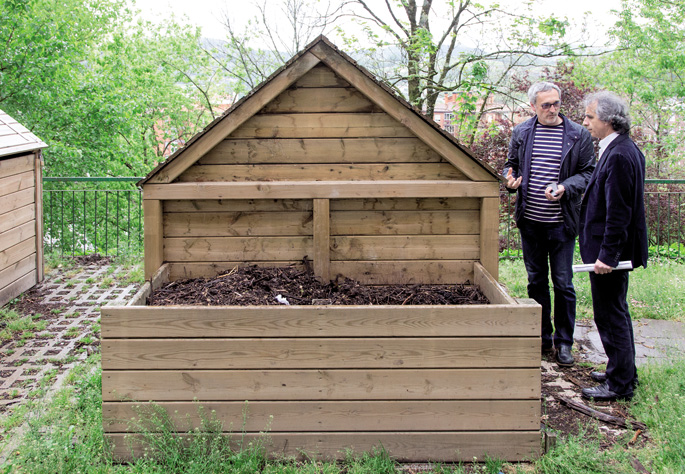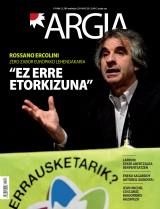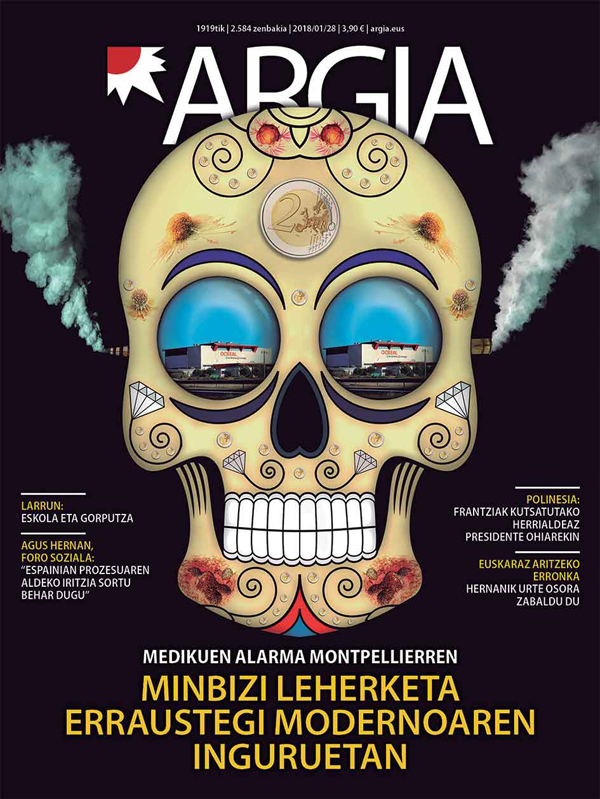"Zero Zabor is a great republic, a bottom-up movement: the future is ours."
- In the morning I was in school with the children in Capannori, I took a lunchtime plane in Pisa, I arrived at Loiu at midnight, on Saturday I spoke to anti-incineration activists in Hernani, I heard “zorionak zuri!” (turned 61) at Sunday morning meal, Zubieta and Usurbil, after lunch the plane will return to school on Monday morning.

“Maisua egunez, aktibista gauez” aldarrikatzen du bere buruaz, gaztetatik lehen mailako hezkuntzako errient dirauenak. Oraindik bizi du ama 96 urterekin. Ama bezala “zimela eta burugogorra” izaki, luzaro bizitzea espero du. Soiltasun handiko gizona, txoriak adina jaten du, baina ez dio uko egingo baso bat ardo oni. Maitatu du Urumeako sagardoa, “txotx!”. Hondakinetan zentraturik bizimodu hobe baten bila izandako bizipenez osatu du liburua: Non bruciamo il futuro (Ez dezagun etorkizuna erre). Bigarrena ari da prestatzen, Zero Zabor haurrei azaldua. Jai eta aste maisu eta aktibista indarrez irauteko, goizero Hatha Yoga ordu erdiz, huts egin gabe.
Here's a man who's had the opportunity to talk to Barack Obama.
Yes, it happened on April 18, 2013. Those of us who received the Goldman Prize that year had that honor. Azam Alwash from Iraq, Jonathan Dial from South Africa, Aleta Baun from Indonesia, Kim Wasserman from the United States and Nora Padilla from Colombia, leaders of waste recycling workers in Bogotá.
Before going to the White House, we received from the World Bank all the task force [technical direction] dealing with waste management and climate change in this institution, which is a palpable sign because the entity that has been funding incinerators has also begun to take an interest in the Zero Zabor experiences, because of the importance they have to increase jobs.
All these relationships are to win one of the prizes awarded by the Goldman Foundation.
Yes. At the end of October 2012, I was called to school. "Hello, Mr Ercolini? Here's the Goldman Foundation, from San Francisco. You won the 2013 Environmental Prize!” I have been working for years at the school in the village of Marlia, near Lucca (Tuscany). After the break, the call caught me giving a geography lesson among 27 5th grade children. The boys and girls laughed when I heard me speak on the phone, in English, to see who I was talking to. She was a woman from San Francisco. “And what did I want?” “He told me that they have given me a very important prize for the work done at Rifiuti Zeron [Zero Zabor].” “How much money?” “150,000 dollars!” And they: But now you're rich! It was hard for me to convince those children that the news was a secret and that they had to be my accomplices keeping it silent…
What did you say to Obama?
In four minutes, I started by saying that, because I'm a elementary school teacher, even the kids would take me for a madman when they said I'd been in the White House with Obama. They all laughed. Then I told him that in Italy we had a lot of sympathy for Michelle, the president's wife, who made the garden near the White House and also the compost. I explained to him our concern that near Washington some propose an incinerator and that our hope is that the public funds of the Americans will be used instead of incineration towards composting, recycling and Zero Garbage strategies.
There are many angry with Obama in the social movements of the United States. In the Zero Waste movement, for example, leading personalities like Brenda Platt or Neil Seldman, who believed in that Yes we can, are very desperate with Obama because his agenda is too constrained by the multinationals: but from the outside I think there is no comparison between Obama and George W. Bush's intervention was linked to the interests of the guerrillas and multinationals.
Tell us the beginning of your fight against incinerators.
Autumn 1995 was warm. The Tuscan region planned to build two new incinerators in the province of Lucca, one in Capanco and one in Pietrasanta. In the face of this, we organised the Non bruciamo il futuro partnership (Do not burn the future). We met in the 40 neighborhoods that Capanno has, the neighbors responded en masse, we gathered a thousand people in the Casa del Lupo who wanted to make the incinerator.
I started working on the subject in a rather curious way at school. One morning I took a black bag full of trash and began to take out glass bottles and pigs, apple and banana remains, cans of Coca Cola and canned, plastic bottles, notebooks, cartons… After classifying in stacks I asked the children: “What do you see in these piles, waste or garbage?” And fast: “Remains!” Then one said that the father is working in the paper factory and told him how they make the news with the papers used, the other one has seen the father making the compost with the fruit shells… “So, where is the trash?” I, and they: “There is no garbage.”
However, from there to an incinerator…
We needed a qualitative leap that would prove a certain stamp of science to our enemies and, above all, to the public that incinerators are very dangerous. That is where we find ourselves helpless, isolated. The greens also said that dioxin was contaminated by old incinerators, but those of new generation not only generate energy, but also pollute no more than other factories or car traffic. I had been with the Green Party from the beginning, I was also a councillor, but they switched from being against incineration to being outside, we said they were green because they had the color of the dollar.
At that time, we did not find any professor at the university in the area who supported, with irrefutable data, our position against incineration. We were helped by the doctors of Democratica Medicine, but the academic world of polytechnics was promoting the next generation of incinerators. And the incineration lobby started a powerful campaign of citizen persuasion.
So, as you say, your special Big Bang happened.
We wanted to bring Barry Commoner, director of the CBSN Natural Biology Systems Center in New York and co-founder of modern environmentalism from the United States. Because of his illness, we were able to bring in Paul Connet, who taught Environmental Chemistry at St. Lawrence University, a well-known study of dioxin transmission in the food chain.
The debate took place on 25 January 1996 in Lucca. The primary culprit for incineration, Del Lungo, was going to come, but… it didn’t appear, leaving only Connet. The room was filled with people, mayors and local councilors, other officials and authorities, journalists, citizens… If the American threw Del Lungo? When they gave him the turn to speak, Connet opened his briefcase and pulled a doll chicken out of it on the spot where the incineration counselor was going to talk, saying, “The yellow chicken!” (Wet chicken).
In Gipuzkoa, we also know Paul Connet, yes, he's a communication teacher.
He said that the culprit is dioxin, a killer that also attacks from modern incinerators. The news is about one-tenth of the dioxins of the old, but in the meantime dioxins have been discovered to be a hundred times more dangerous than previously thought. They do not biodegrade and are damaged twice: when wind and temperature spread through the air and enter the food chain. The woman, moreover, has a tragic way to expel this poison that accumulates in fat: it is passed on to the baby that leads in pregnancy and thus to future generations. Then there are heavy metals, cadmium, mercury, lead, arsenic and other poisons…
To put it mildly, it is false that the incinerator “closes the waste cycle”: burning one hundred tonnes of waste leaves 30 tonnes, of which 10% are dangerous ashes that need special landfills. Here's why. Incineration reduces selective collection and recycling and encourages the consumption of hipers so dear to the multinationals.
But you won in Lucca.
We managed to paralyse both the projects of Capannorico and Pietrasanta, and later in 2008 the former incinerator of Castelnuovo de Cafagnana was also closed.
Did you not stop Pietrasantá after he had built it and set it in motion?
In 1974, Pietrasanta had the former Falascaia incinerator. Citizens constantly denounced that it caused great damage to their health. And when it seemed that its closure would solve the problem, in 1997 the authorities decided instead to build a new one. People were told that it was the most controlled system in Europe, that it continually measured dioxin emissions, etc.
Two years after the burning of the rubble, the management of the Falascalia was handed over to the French multinational Veolia and soon came to court an anonymous letter that was probably the revenge of someone who had lost power: In Falascaia, a software was installed to falsify the measurement of pollution, which resulted in a dozen data reductions. Years later, like the Volkswagen car scandal.
In this period, in 2003, the analyses showed that the contamination of the incinerator was twelve times higher than that legally permitted. And at night we caught them flushing polluted water in the stream. Finally, the state closed the Pietrasanta oven in 2010. Today Lucca is the territory “Incinerator Free”.
With these achievements, it is no wonder that from the surroundings you ask for help.
Since before, we were called since that Big Bang of 1996 throughout Italy, Tuscany, Lazio, Ligurua, Campania… We turn our partnership into “Environment and Future”. In 2004 we organised the Rifiuti Zero network in Italy, which had previously contacted movements around the world. Capannori became the first Zero Trash village in Italy. And the Zero Waste World Congress was held in Naples in 2009.
Readers will recall the rubbish of Naples, the crisis in southern Italy, which television showed with spectacular images.
In Naples, and in general in Campania, waste was managed in any way. The authorities had acted recklessly in Campania, completely rejected selective collection and, as if they were very deaf, they had opted for mega-incinerators grouped with untransparent companies.
The tragedy of the Neapolitan trash began a process of maturation in which thousands of citizens began to demand selective collection in the midst of accumulation. Rifiuti Zero and the multitude of collectives and witness associations, as well as numerous meetings, demonstrations and gatherings, participated together.
Not all peacefully completed.
I still have before me pictures of 29 August 2004 in which some 30,000 people left on foot to the construction sites of the Acerra incinerator, and how they arrested that crowd by throwing tear bombs from helicopters to women and children. They paralyzed the Zero Zabor message by treating people as if they were an enemy, militarizing rest places, attacking citizens who wanted better waste management with the police.
It is true that in the end the incinerator of Acerra was built, against the will of the people. But at the same time the selective door-to-door pick-up and the Zero Zabor model have spread in Salerno, Benevento, Avellino and many other municipalities. By 2014, Salerno, with its 140,000 inhabitants, had exceeded 70% of selective collection, followed by Benevento, Portici, Agerola, Torre del Greco, Maiori, Ravello and many more.
What message did you bring from Italy to Euskal Herria?
I was in Hernani in 2010, I've been here four times since. Six years ago things were not so clear, on the one hand there was a lot of fear of incineration, but on the other hand we had to prove whether Puerta a Puerta was the best solution for Hernani. Today we can say that the collection of Door to Door and the best practices of Trash Zero give good results in Hernani. I have seen Hernani in Usurbil and I know that there are many more in Gipuzkoa.
I was surprised by the composting system. I believe that in Hernani there is the best composting system in Europe. I'd like to copy your system to Capanco in our village. But in the rest of the Zero Zabor system, Hernani is in the right direction, surely because society has been deeply involved, because local society wants to take part in that path towards Zero Zabor.
It is a very strong message for politicians. I don't mean municipal politicians, because I've seen that the mayor is very much in favor of promoting Zero Zabor's path. But it's a very strong message to Donostian politicians.
So tell the authorities in San Sebastian.
It is not possible to promote incineration when society is pushing for it not to be built. The European governments have taken the same course. I have just been in Ljubljana (Slovenia). Ljubljana is the first European capital to proclaim the objective of Zero Waste.
If Ljubljana is able to move in that direction, I do not understand why San Sebastian, the European Capital of Culture, wants to return to the past. It is not possible. Please, it is very important to avoid this tragic error.
Incineration has passed. Incineration is burning our future. We need the future, a future for young people. Young people get very involved, because they look at the garbage bag with the eyes of those who have a future. We cannot burn the future of young people.
The message to politicians is that society is doing what it deserves. You politicians must do the same, adopt the objectives of local communities and ask companies to do the same. We do not want non-recyclable or non-repairable products, non-compostable products. Promote a new design, avoid waste, avoid garbage. The community is working very well, collecting selectively between 70 and 80 percent of the waste. It is up to politicians and businesses to solve the rest of the problem. It's a message. democracy!
Here everyone talks about democracy...
Zero Zabor wants to be an extensive republic of nationalities and experiences that converge in the sea of good practices. A beautiful republic stretching from the bottom, because Zero Zabor is a bottom-up movement. Societies that want to be sovereign in their places of residence, in the exercise of democracy. These kinds of societies have a future, and they know how to build consensus at the lower level. In descending models, decisions are made, but with the risk of being breached. No, the future is ours.
“Zero Zabor mugimendua da lokala eta globala. Gure indarra da elkarrekin konektatzea Europa eta mundu mailako batailak. Politikariak, maila oso txikiko politikariak, ez dira ohartzen Zero Zabor mugimendu globala dela. Zuen arazoa lekuan bertan daukazuen bitartean, politikariak lasai egongo dira, badakite nola kontrolatu. Baina gaia Europan barrena zabaltzen baldin baduzue… Gandhik esan zuen: hasieran mespretxatuko zaituzte edo ignoratuko; gero kriminalizatu egingo zaituzte, hainbeste lagun pertsegitu dituzte errausketaren lobbyak eta politikariek; eta azkenean irabaziko duzu”.
Abenduaren 20ko Bergarako Ohiko Udal Batzarrean mozioa aurkeztu dute bi herritarrek eta gaia eztabaidatu dute ondoren udaleko alderdi politikoek eta herritarrek. Mozio horrek laburtzen ditu Bergarako erraustegiaren auziko puntu nagusiak.
























